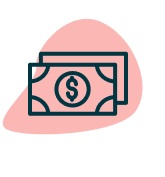Business Line of Credit: What It Is and How to Get One
Last updated Feb. 24, 2025
If you’re in search of a flexible form of financing for your small business—one that can help you handle cash flow gaps, access more working capital, address an emergency, or take advantage of a business opportunity—then a business line of credit may be a fit.
A business line of credit is a type of small-business loan
Ready to shop and apply? Begin by entering your desired loan amount below, and we'll get started on matching you with the best line of credit options for your small business.
How much do you need?
No cost to you
Your credit score won't be impacted
Compare multiple lenders with one application
Business Line of Credit at a Glance
Repayment Term6 to 24 months
Interest Rates10% to 99%
Funding SpeedAs fast as 1 day
Line Amount$1,000 to $1 million
How Does a Business Line of Credit Work?
Business lines of credit are similar to credit cards: A lender approves you for a set amount of financing (similar to a credit limit), which you can draw from at your discretion.
Once you repay what you’ve spent, you can continue to draw capital from your line of credit. This type of financing is considered revolving credit
Types of Business Lines of Credit
A business line of credit can be secured or unsecured.
- Secured business line of credit. A secured line of credit is backed by
physical collateral - Unsecured business line of credit. An unsecured credit line doesn’t require physical collateral. Some lenders, however, will still require a
personal guarantee UCC lien
Because secured business lines of credit help mitigate risk for the lender, they tend to have more competitive rates and terms than unsecured options. Unsecured lines of credit, however, can still be a good option for those who need fast access to capital—as well as for new companies that don’t have enough collateral to offer.
Pros and Cons of a Business Line of Credit
Pros
✔️ Only pay interest on the funds you draw.
✔️ Flexible funding that can be used for a variety of short-term needs.
✔️ Can be accessible to startups and borrowers with bad credit
Cons
✖️ May have to pay additional fees (draw fees, account maintenance fees, etc.) that increase the total cost.
✖️ Not suitable for large purchases or investments.
✖️ Can have shorter repayment terms than more traditional loans.
Qualifications for a Business Line of Credit
*Based on past Fundera customers


How to Qualify and Apply for a Business Line of Credit
If you think a business line of credit is the right option for you, follow these steps to see if you qualify and start your application.
Determine what type of funding you need
Think about how much capital you need and how you plan to use it. You should also consider whether you’d prefer a secured or unsecured line of credit. If you’re looking for a secured line of credit, you’ll want to make sure you have a valuation of the collateral you plan to use.
Evaluate your qualifications
Most lenders will evaluate your business using your personal credit score, time in operation, and annual revenue. The specific business line of credit requirements you’ll need to meet, however, will vary based on the lender.
In general, it’s helpful to be able to meet the following minimum qualifications:
- Personal credit score: 600+
- Time in business: Six months to one year
- Annual revenue: $50,000 to $100,000+
Compare lenders
Research and compare multiple options to find the best fit for you. You’ll want to look for a lender whose requirements you can meet and one who offers the type of credit line you need. Keep in mind that banks and SBA lenders Online lenders
Complete and submit your application
If you’re working with an online lender, you’ll usually be able to complete the application process
In general, you’ll need:
- Copy of personal identification
- Business employer identification number
- Personal and business bank statements
- Personal and business tax returns
- Financial statements, such as a profit and loss statement and balance sheet
Online lenders may be able to approve and fund your application as quickly as the same day. Traditional lenders may take anywhere from several days to several weeks to issue funding.
Fundera Can Help
We’re here to take some of the work of finding a small business line of credit off your plate.
Just answer a few questions—with no impact to your credit score and free of obligation—to see which lines of credit you qualify for. One of our trained sales associates will personally advise you through the entire process, from comparing options to signing your agreement.
Let’s get you funded!
How much do you need?
No cost to you
Your credit score won't be impacted
Compare multiple lenders with one application